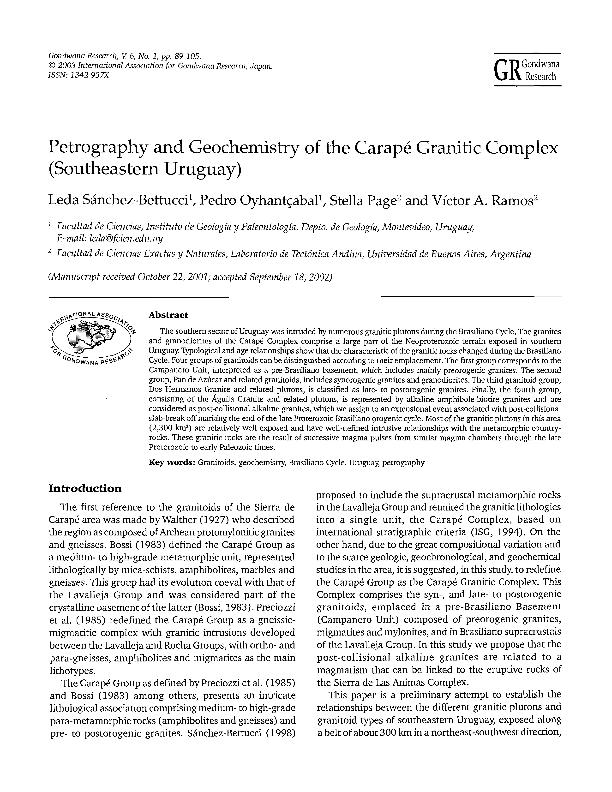Mostrar el registro sencillo del ítem
dc.contributor.author
Bettucci Sanchez, Leda

dc.contributor.author
Oyhantçabal, Pedro
dc.contributor.author
Page, Stella
dc.contributor.author
Ramos, Victor Alberto

dc.date.available
2019-09-13T19:26:26Z
dc.date.issued
2004-12
dc.identifier.citation
Bettucci Sanchez, Leda; Oyhantçabal, Pedro; Page, Stella; Ramos, Victor Alberto; Petrography and geochemistry of the Carapé Granitic Complex (Southeastern Uruguay); Elsevier Science; Gondwana Research; 6; 1; 12-2004; 89-105
dc.identifier.issn
1342-937X
dc.identifier.uri
http://hdl.handle.net/11336/83577
dc.description.abstract
The southern sector of Uruguay was intruded by numerous granitic plutons during the Brasiliano Cycle. The granites and granodiorites of the Carapé Complex comprise a large part of the Neoproterozoic terrain exposed in southern Uruguay. Typological and age relationships show that the characteristic of the granitic rocks changed during the Brasiliano Cycle. Four groups of granitoids can be distinguished according to their emplacement. The first group corresponds to the Campanero Unit, interpreted as a pre-Brasiliano basement, which includes mainly preorogenic granites. The second group, Pan de Azúcar and related granitoids, includes synorogenic granites and granodiorites. The third granitoid group, Dos Hermanos Granite and related plutons, is classified as late- to postorogenic granites. Finally, the fourth group, consisting of the Águila Granite and related plutons, is represented by alkaline amphibole-biotite granites and are considered as post-collisional alkaline granites, which we assign to an extensional event associated with post-collisional slab-break off marking the end of the late Proterozoic Brasiliano orogenic cycle. Most of the granitic plutons in this area (2,300 km2) are relatively well exposed and have well-defined intrusive relationships with the metamorphic country-rocks. These granitic rocks are the result of successive magma pulses from similar magma chambers through the late Proterozoic to early Paleozoic times.
dc.format
application/pdf
dc.language.iso
eng
dc.publisher
Elsevier Science

dc.rights
info:eu-repo/semantics/openAccess
dc.rights.uri
https://creativecommons.org/licenses/by-nc-sa/2.5/ar/
dc.subject
Brasiliano Cycle
dc.subject
Geochemistry
dc.subject
Granitoids
dc.subject
Petrography
dc.subject
Uruguay
dc.subject.classification
Geociencias multidisciplinaria

dc.subject.classification
Ciencias de la Tierra y relacionadas con el Medio Ambiente

dc.subject.classification
CIENCIAS NATURALES Y EXACTAS

dc.title
Petrography and geochemistry of the Carapé Granitic Complex (Southeastern Uruguay)
dc.type
info:eu-repo/semantics/article
dc.type
info:ar-repo/semantics/artículo
dc.type
info:eu-repo/semantics/publishedVersion
dc.date.updated
2019-07-15T14:20:16Z
dc.journal.volume
6
dc.journal.number
1
dc.journal.pagination
89-105
dc.journal.pais
Países Bajos

dc.journal.ciudad
Amsterdam
dc.description.fil
Fil: Bettucci Sanchez, Leda. Universidad de la República. Facultad de Ciencias; Uruguay
dc.description.fil
Fil: Oyhantçabal, Pedro. Universidad de la República. Facultad de Ciencias; Uruguay
dc.description.fil
Fil: Page, Stella. Universidad de Buenos Aires. Facultad de Ciencias Exactas y Naturales. Departamento de Geología. Laboratorio de Tectónica Andina; Argentina
dc.description.fil
Fil: Ramos, Victor Alberto. Consejo Nacional de Investigaciones Científicas y Técnicas; Argentina. Universidad de Buenos Aires. Facultad de Ciencias Exactas y Naturales. Departamento de Geología. Laboratorio de Tectónica Andina; Argentina
dc.journal.title
Gondwana Research

dc.relation.alternativeid
info:eu-repo/semantics/altIdentifier/url/https://www.sciencedirect.com/science/article/pii/S1342937X05706468
dc.relation.alternativeid
info:eu-repo/semantics/altIdentifier/doi/https://doi.org/10.1016/S1342-937X(05)70646-8
Archivos asociados
